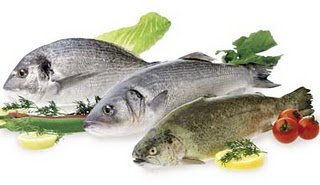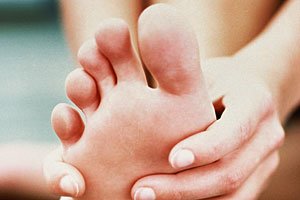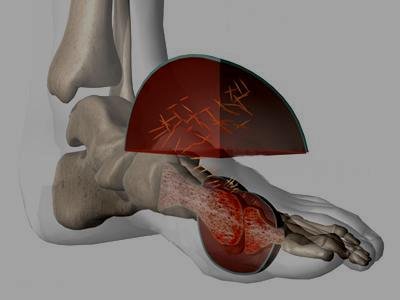Gout is a form of arthritis (joint inflammation) usually occurring in the cooler extremities of the body, like feet or toes.
It is general disease, constitutional and very often hereditary, characterized by an excess of uric acid in blood.
The uric acid s not eliminated in the urine as normal, but left such as needle-like crystal deposits in the joints or other body parts causing redness, swelling and extreme pain. Also the disease is characterized by warmth (inflammation) and by loss of function of the joint.
↓ Gout (needle crystal deposits) ↓
Without proper treatment, gout is a disease that presents recurrent (acute) can cause severe damage frequencies of joints, tendons and other tissues. Gout is a disease most common among the male population.
Causes
- There is an increase in uric acid production (genetic disease);
- Chronic kidney disease: The kidneys are not functioning sufficiently to eliminate uric acid;
- Hypertension;
- Hypothyroidism (thyroid gland disorder characterized by deficiency of hormones secreted at this level);
- There is an increased consumption of foods containing purines. Purine is a chemical found in certain foods that forms uric acid. ( high in purines is a diet rich in meat and seafood);
- Obesity; associated with rapid weight loss or decreased weight patients secondary to drastic changes in diet or due to the use of certain treatments;
- Moderate or chronic consumption of alcohol, especially beer;
- Chronic treatment with aspirin or products containing niacin (nicotinic acid); diuretics;
- Chemotherapy (drugs used to treat cancer, causes rapid death of malignant cells);
- Immunosuppressant (drugs that reduce immunity) such as cyclosporine, used in preventing graft rejection after organ transplant;
- Lead poisoning
Risk Factors
There are some problems that appear more frequently in people diagnosed with gout than in the healthy population, although there is no conclusive medical studies have shown this clearly.
It is believed that gout is common risk factors with other diseases:
Obesity; hypertension; diabetes; kidney disease; arteriosclerosis; heart disease.
Obesity is a major risk factor for gout, so losing weight can help you lower your risk of attacks.
Diet
Details: A gout diet reduces your intake of foods that are high in purines, which helps control your body’s production of uric acid. If you’re overweight or obese, lose weight. However, avoid fasting and rapid weight loss because these can promote a gout attack. Drink plenty of fluids to help flush uric acid from your body. Also avoid high-protein diets, which can cause you to produce too much uric acid (hyperuricemia).
 Foods to Avoid: (High Purine Foods)
Foods to Avoid: (High Purine Foods)
Beer; organ meat (brains, kidney, liver); anchovies; game meats; gravies; yeast; meat extracts; sardines; herring; mackerel; scallops; red meat (beef, pork and lamb).
Because all animal protein contains purines, limit your intake to 4 to 6 ounces (113 to 170 grams) daily.
It has been suggested that using tofu (from soybeans) instead of meat could be helpful.
Limit or avoid alcohol: Alcohol interferes with the elimination of uric acid from your body. Drinking beer, in particular, has been linked to gout attacks. If you’re having an attack, avoid alcohol. However, when you’re not having an attack, drinking one or two 5-ounce (148 milliliter) servings a day of wine is not likely to increase your risk.
 Foods to eat in Moderation: (Medium Purine Foods)
Foods to eat in Moderation: (Medium Purine Foods)
Fresh and saltwater fish, shellfish, eel, meat, poultry, meat soups and broth, asparagus , mushrooms, cauliflower, spinach, legumes, oatmeal, bran, wheat germ, whole-grain breads and cereals, eggs. Eat more whole grains and fruits and vegetables and fewer refined carbohydrates, such as white bread, cakes and candy.
NO Restriction: (Low Purine Foods)
 Breads and cereals (low-fiber, white flour, or refined grain types), nuts, peanut butter. Vegetables not high in purines, soups – cream style or vegetable without meat extract, coffee, tea, fruit juices, soft drinks, gelatin, sugar, low fat cheeses (Some studies have shown that drinking skim or low-fat milk and eating foods made with them, such as yogurt, help reduce the risk of gout. Aim for adequate dairy intake of 16 to 24 fluid ounces (473 to 710 milliliters) daily).
Breads and cereals (low-fiber, white flour, or refined grain types), nuts, peanut butter. Vegetables not high in purines, soups – cream style or vegetable without meat extract, coffee, tea, fruit juices, soft drinks, gelatin, sugar, low fat cheeses (Some studies have shown that drinking skim or low-fat milk and eating foods made with them, such as yogurt, help reduce the risk of gout. Aim for adequate dairy intake of 16 to 24 fluid ounces (473 to 710 milliliters) daily).
You can increase your protein by including more plant-based sources, such as beans and legumes. This switch will also help you cut down on saturated fats, which may indirectly contribute to obesity and gout.
Drink plenty of fluids:
In particularly water. Fluids can help remove uric acid from your body. Aim for eight to 16 8-ounce (237 milliliter) glasses a day.
Some people have found cherry or strawberry juice helpful. It is believed that, some chemicals contained in dark berries may help reduce the inflammation and lower the uric acid.
Gout Medication:
Following a gout diet can help you limit your body’s uric acid production and increase its elimination. It’s not likely to lower the uric acid concentration in your blood enough to treat your gout without medication, but it may help decrease the number of attacks and limit their severity.
Many experts suggest that medications for gout have reduced the need for dietary restrictions, but some modifications can decrease the severity or frequency of gout attacks.
Dietary modification may also be preferred by people who cannot tolerate gout medications.



